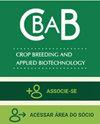凤梨F1基因型的选择及其接种枯殖镰刀菌的反应
IF 1.1
4区 农林科学
Q2 Agricultural and Biological Sciences
引用次数: 0
摘要
本文章由计算机程序翻译,如有差异,请以英文原文为准。
Selection of F1 genotypes of pineapple and reaction to inoculation with a Fusarium guttiforme isolate
Abstract Fusariosis (Fusarium guttiforme) is the most destructive disease of the pineapple crop in Brazil. The aim of this study was to evaluate the reaction to an isolate in pineapple genotypes selected for crownless fruit weight (CFW) and total soluble solids (TSS). A total of 1,125 genotypes ('BRS Imperial'×'Pérola') were evaluated. Selection for greatest CFW and TSS was performed during the sexual cycle. The isolate was inoculated on slip-type plantlets using the immersion technique. Plantlets were evaluated for disease intensity in the stem, attributing scores from 0 to 5. Eighteen genotypes were selected with values from 1.514 to 3.307 g (CFW) and from 14.6 to 19.4 °Brix (TSS). Six genotypes reached the highest level of survival against the IT-01 isolate. Selected genotypes have agronomic traits superior to those of their parents, which qualify them to be cycled back into the plant breeding program of the Instituto Agronômico de Pernambuco - IPA.
求助全文
通过发布文献求助,成功后即可免费获取论文全文。
去求助
来源期刊
CiteScore
2.40
自引率
13.30%
发文量
25
审稿时长
6-12 weeks
期刊介绍:
The CBAB – CROP BREEDING AND APPLIED BIOTECHNOLOGY (ISSN 1984-7033) – is the official quarterly journal of the Brazilian Society of Plant Breeding, abbreviated CROP BREED APPL BIOTECHNOL.
It publishes original scientific articles, which contribute to the scientific and technological development of plant breeding and agriculture. Articles should be to do with basic and applied research on improvement of perennial and annual plants, within the fields of genetics, conservation of germplasm, biotechnology, genomics, cytogenetics, experimental statistics, seeds, food quality, biotic and abiotic stress, and correlated areas. The article must be unpublished. Simultaneous submitting to another periodical is ruled out. Authors are held solely responsible for the opinions and ideas expressed, which do not necessarily reflect the view of the Editorial board. However, the Editorial board reserves the right to suggest or ask for any modifications required. The journal adopts the Ithenticate software for identification of plagiarism. Complete or partial reproduction of articles is permitted, provided the source is cited. All content of the journal, except where identified, is licensed under a Creative Commons attribution-type BY. All articles are published free of charge. This is an open access journal.

 求助内容:
求助内容: 应助结果提醒方式:
应助结果提醒方式:


